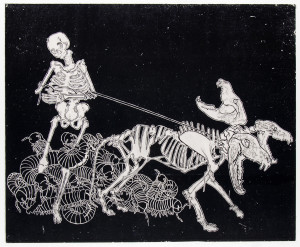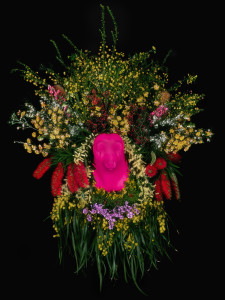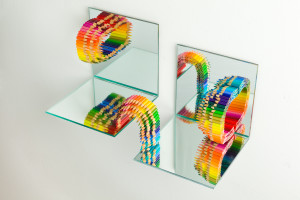
There is nothing quite like a graduate exhibition. I can say that having been the hapless soul to volunteer myself to coordinate not just one, but two grad shows. They can be monstrous, living, breathing beasts on the cusp of chaos.
Grad shows can also be a curatorial nightmare! These unwieldy shows involve hundreds of artworks of various size, form, media, meaning and quality, making for a highly challenging install. Even though these exhibitions are one of the biggest events of the year for each South Australian art institution, each school has limited exhibition space to cater for the vast number of graduating artists, meaning while many of the works are hung and presented in a formal gallery space, others are relegated to the surrounding corridors and classrooms. This is an unavoidable curatorial decision. Opening nights are when this beast threatens to tip out of control. Overcrowded and sweaty in the belly of the beast, it can be hard to discern the order that each individual artist has sought to uncover.
Despite all their challenges, graduate exhibitions are great fun. They are a ceremony, a sacred rite of passage, a celebration of student achievement, and recognition of years of sacrifice for a higher education in the arts. They are an opportunity for students to showcase a depth of research, quality craftsmanship, resolved ideas and an original aesthetic in their final body of work. Plus, they bring people together.
Grad shows mark a state of progression and transition. From art student to art life is a natural not artificial change. Each art school equips students with tools from which to proceed, including a bounty of knowledge, skills, resources, research methodologies, networks and most importantly, friendships. These tools have the power to feed the hungry giant, restore order and keep the peace.
For 17 years the Helpmann Academy has selected the freshest and most interesting work from the 3 major art institutions in our state. This year’s exhibition develops further discourse around the stirring beast that is the ‘grad show’. The beast is lulled into a false sense of security in the order that emerges in the 29 artists’ work in the Helpmann Academy Graduate Exhibition 2012. Lindsey Bryant’s woodcuts depict a potent mortality, through her vision of a three-headed skeletal beast rearing to take off into the hollow darkness of the ink stained page. Then there’s CJ Taylor’s photo portrait of man’s best friend; a fluorescent pink dingo cartouche. Its doggy face held, framed in a mane of native Australian flora and set against dramatic black gloss; a scene from Taylor’s “life and art”, a post colonial take on nature and unreality. Claire Marsh presents her beast as an innocent creature in a state of trauma in her sculpture series. And hundreds of spying eyes stitched into the upholstery of Fiona Roberts’ paranoid Scopophilia chair gaze up at the inquisitive viewer.

Christobel Kelly presents the make-believe in the broken narratives of her monotype series. Abram Phillips recollects a mundane existence in his realistic rendering of himself and his surroundings in his oil on linen series. Along the same vein Simon de Boer “attempts to capture the essence of the subject” through painterly mark making of everyday subjects. Images of the artist appear again, but in radically different versions, in the photographic work of Amy Hermann and Sundari Carmody. These are often blurred, warped and somewhat in-motion performances that explore both external and internal identities. Rebecca Hastings’ lifelike portrayals of the often challenging and undesirable nature of the relationship between mother and child rewrite history paintings and redefine the meaning of ‘motherhood’ for the 21st century.
Human perception of both self and other creeps into the works of André Lawrence and Yuro Cuchor. Whereas Sally Wickes questions our perception of weight, mass, density and gravity in Flight, a series of bronze feather sculptures. Robin Hatherall queries, “what is normal?” in his Fat, Stained and Proud and Garden Spirit ceramic characters. Others, such as Arlon Hall, need time to reflect and get lost in their own colourful paint dripping dreams.
Both Alexander Lofting and Ekaterina Vostroukhina want to remember floating doorways and unknown locations. Both artists hold onto a memory of the familiar in this time of transition. Likewise, Bridgette Minuzzo has collected fragments of imagery from her home and surroundings to reclaim the familiar through projections of wallpaper-like patterns. Jemimah Davis, Samantha Mott and Jesse Price utilise similar techniques of repetition of object and shape, mirrored imagery, pattern and colour to reinvigorate the ordinary into extraordinary, all are joyful reimaginings.

This year’s exhibition surveys the practices of a diverse group of artists. From chaos to order – these works were chosen to come together, reside next to one another, talk to each other, share ideas and draw lines of connectivity. Linking themes of the everyday, the unknown and familiar, questions of identity and perception, memory, the home, and to concurrent threads of social awareness, environmental consciousness and representations of nature.
The beast curls up in a cozy corner, happily gnawing on these nuggets. Slowly falling into a peaceful slumber … until next year!
From Chaos to Order was a commissioned catalogue essay for Helpmann Academy Graduate Exhibition 2012 exhibited at the Drill Hall from 22 February-18 March.